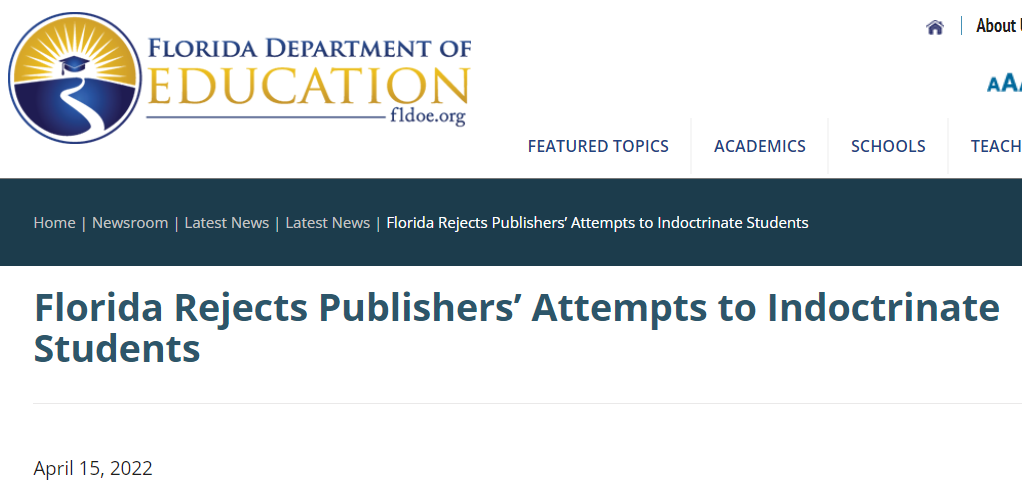
Since I wrote a long post yesterday I wasn’t going to post today, but this is too funny.
Tallahassee, Fla., April 15, 2022 – Today, Commissioner of Education Richard Corcoran approved Florida’s initial adoption list for mathematics instructional materials properly aligned to Florida’s Benchmarks for Excellent Student Thinking (B.E.S.T.) Standards. The approved list followed a thorough review of submissions at the Department, which found 41 percent of the submitted textbooks were impermissible with either Florida’s new standards or contained prohibited topics – the most in Florida’s history. Reasons for rejecting textbooks included references to Critical Race Theory (CRT), inclusions of Common Core, and the unsolicited addition of Social Emotional Learning (SEL) in mathematics. The highest number of books rejected were for grade levels K-5, where an alarming 71 percent were not appropriately aligned with Florida standards or included prohibited topics and unsolicited strategies. Despite rejecting 41 percent of materials submitted, every core mathematics course and grade is covered with at least one textbook.
Oh, those dastardly textbook publishers. But this left me wondering how they brilliantly managed to work critical race theory into math textbooks. Are there problems that discuss housing discrimination? Tampa Bay broadcaster WTSP says most of the rejected books were for grades K through 5, which kind of deepens the mystery.
The South Florida Sun Sentinel wondered the same thing.
The education department didn’t provide an example of critical race theory in the rejected textbooks, instead sending a list of two documents that did not contain specific examples.
Critical race theory, first proposed by legal scholars, says racism is embedded in the country’s institutions. Historically, the theory has been a law or graduate school subject and not one taught in public schools.
I am a veteran of the K-12 textbook industry. I assure you that it’s the primary goal of textbook publishers to sell books, not to indoctrinate anybody. And usually they bend over backward trying to accommodate what state textbook adoption committees want, even if the editorial staff grumbles about it.
But it’s also the case that textbook series are expensive things. They are supposed to be visually appealing, meaning they have lots of pretty color illustrations, usually on every spread (two facing pages). Spreads with just type are to be avoided. But this is expensive, and a lot of the cost happens in the printing set up, or prepress, phase. That cost is the same whether you are printing 10 books or 100,000 books. So, obviously, the per unit cost goes down the more identical books you can print and sell.
It’s also the case that there are new printing technologies that allow for small-batch printing of books with color illustrations at lower cost, but I don’t know where the industry is with that. It’s possible smaller publishers who aren’t going for nationwide sales would be better positioned to produce boutique books to order.
Anyway, for this reason, publishers don’t want to publish 50 wildly different editions of the same series. Ideally, they can publish textbooks that are innocuous enough to not push the buttons of anyone on a textbook committee. If one state insists on something that would be a poison pill elsewhere, ideally this can be accommodated by minor text tweaks that don’t require changing the illustrations, which reduces prepress costs somewhat. What they don’t want to do is develop a math textbook for one state that is based on an entirely different approach to math teaching than what is commonly used elsewhere.
Of course, I really, really wanted to know which textbook publishers were rejected, but I couldn’t find that information. On the list of publishers accepted, the only names I recognized were Houghton Mifflin Harcourt and McGraw Hill, for whom I worked for a while to produce a math K-12 series, ca. 2003-2004. Two of the big shots of the industry that don’t seem to be represented are Pearson and Scholastic. I’d love to know if they were rejected or just decided to not bother.
WaPo:
What could be in a math textbook that would promote critical race theory and other “prohibited” subjects? Though the department described the textbook review process as “transparent,” it did not mention which textbooks had been rejected or cite examples from the offending passages.
“It seems that some publishers attempted to slap a coat of paint on an old house built on the foundation of Common Core, and indoctrinating concepts like race essentialism, especially, bizarrely, for elementary school students,” Florida Gov. Ron DeSantis (R) was quoted as saying in the announcement.
What “race essentialism”? Especially in K-5 textbooks? The only way race was ever represented in any math textbook series I worked on was in the illustrations, which back in my day were required to depict children of all races and not just white ones. Did DeSantis see photos of black and brown children in the textbooks and freak out?
Florida’s education department also mentioned that some of the textbooks were linked to Common Core, a reference to the Common Core State Standards that Florida and most other states adopted more than a dozen years ago. The standards have since been replaced in a number of states, including Florida, which has seen a succession of different content standards over the last dozen years.
The BEST standards were adopted two years ago, when even Jacob Oliva, who is Florida’s chancellor for the Education Department’s division of public schools, acknowledged that some of the new standards were similar to Common Core. [Florida commissioner of education Richard] Corcoran said that wasn’t true.
Maybe 2 + 2 no longer equals 4 in Florida. Who knows?
